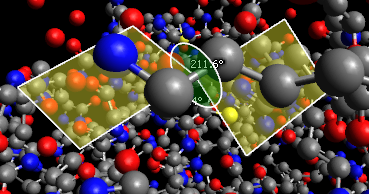 Avogadro 0.2 is an early stage release of a new open source molecular viewer and editor. It's available for Windows, Linux and MacOSX, so there's no excuse not to try it. I took it for a test drive for the first time a week or so ago (this was on Windows), and was very impressed. Sure, there are some rough edges, as you might expect with such a low version number, but it's already capable of matching the existing competition and is sure to become the molecular editor of choice with the next release.
Avogadro 0.2 is an early stage release of a new open source molecular viewer and editor. It's available for Windows, Linux and MacOSX, so there's no excuse not to try it. I took it for a test drive for the first time a week or so ago (this was on Windows), and was very impressed. Sure, there are some rough edges, as you might expect with such a low version number, but it's already capable of matching the existing competition and is sure to become the molecular editor of choice with the next release.Once it starts, open up a molecular structure file (for example, a PDB entry) and immediately choose the navigation tool (next to the Pencil in the Tools toolbar). The left mouse button rotates the molecule, the middle zooms, and the right translates. So far, so Rasmol.
However, it's the attention to detail in the user interface that makes Avogadro stand out from the crowd. If the initial click to rotate is on an atom, the molecule rotates around the atom, whereas otherwise the molecule rotates around its centroid. Something else you will notice is the eye-candy, which really aids clarity. When rotating, a set of curvy arrows indicate the degree of rotation. If you choose the Bond Centric Manipulation Tool (indicated by an icon containing the number 90) and click on a bond, you will see bond angles lovingly displayed as semi-transparent segments. Then if you click and drag on an atom adjacent to the bond, the visualisation of the dihedral angles as you alter them is pretty cool (see below).

So what else has Avogadro got? I didn't try the molecular builder, the force-field optimisation nor the export to POV-Ray, but they're all there. I'm more interested in what's to come. Avogadro uses a plugin architecture, which means that it will be easy to incorporate third-party add-ons. Along with forthcoming support for scripting languages, this will allow me to incorporate elements of cclib or GaussSum into Avogadro.
But that's all in the future. For now, I'm just wondering how many times I can rotate this dihedral angle until it falls off...
Thanks for the shameless plug!
ReplyDeleteWe're always interested in what people feel the "rough edges" are at this point. So Noel suggested a few things, and I think we got most in the SVN trunk right now. (DId you file bugs on all your complaints Noel?)
You mention extensibility. We've worked hard on the API for plugins -- almost everything you see is a plugin already, so we know the interface works well.
We're also based on Open Babel, so it's easy to support more file formats, more force fields, etc.
But Noel didn't notice the most fun. Rendering allows multiple render options at once. Try a wireframe and a protein ribbon. Or balls-and-sticks and a transparent vdW sphere option. This makes it easy to add "overlays" of new data like surfaces.
That's indeed a nice way to display torsion angles.
ReplyDelete